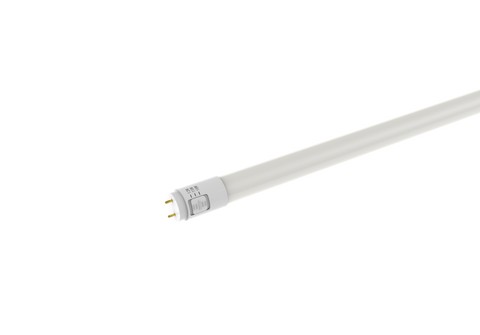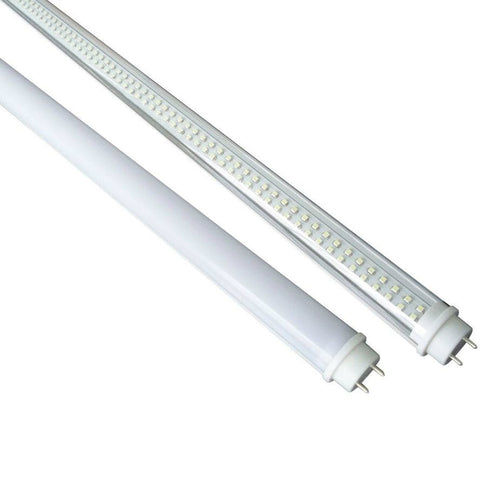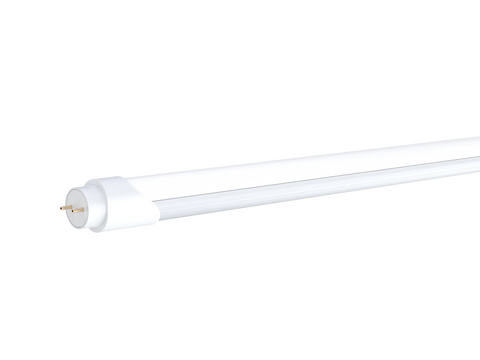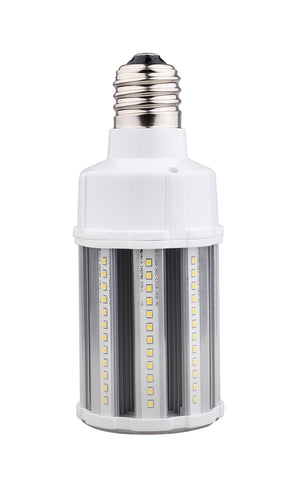Types of Light Bulb Bases
You're probably familiar with Edison-style bulbs, but today, there are also other types of light bulb bases. Let's run down each kind.
Edison Bases
Edison bases, named after the inventor Thomas Edison, are one of the most ubiquitous and historically significant light bulb base types. These bases employ a screw mechanism that allows the bulb to be twisted into the socket, creating a stable electrical connection that's suitable for a wide range of lighting environments.
Technical Overview and Common Light Bulb Base Sizes
The designation of an Edison base includes an "E" followed by a number, which indicates the diameter of the base in millimeters. This simple yet versatile design has been standardized in several light bulb base sizes to cater to different lighting needs:
- E12 (Candelabra Base): Typically the smallest of the Edison screw base bulbs, E12 bases have a diameter of 12 mm. These are often found in decorative applications such as chandelier lighting, small lamps, and sometimes holiday lighting strings, where a petite and less obtrusive bulb is desired.
- E14 (Small Edison Screw Base): Slightly larger than the E12, the E14 has a diameter of 14 mm. It's commonly used throughout Europe and is suitable for many household appliances and smaller lighting fixtures.
- E17 (Intermediate Base): With a diameter of 17 mm, the E17 base serves a niche between smaller decorative bulbs and larger general-purpose bulbs. It's used in appliances, pendant lights, and refrigeration lighting.
- E26 (Medium Base): The most common size in North America, the E26 base measures 26 mm in diameter. It's the standard size for most residential and commercial lighting fixtures, accommodating a wide range of bulb types from standard incandescents and LEDs to more specialized styles like globes and reflectors.
- E39 (Mogul Base): The largest of the standard Edison bases, the E39 has a diameter of 39 mm and is used primarily in commercial and industrial settings. These bases support high-wattage bulbs used in street lamps, high bay lighting, and large-area lighting fixtures where intense illumination is necessary.
Applications and Benefits
Edison screw bases have remained popular due to their ease of use and the reliable contact they provide, which is essential for a stable power supply to the bulb. Here's how different sizes fit into various applications:
- Versatility: From tiny decorative elements to robust industrial fixtures, Edison bases provide solutions across a spectrum of lighting needs, making them highly versatile.
- Durability: The screw-in mechanism is simple and durable, allowing for easy installation and replacement without specialized tools or training.
- Compatibility: Edison bases accommodate a wide range of bulb types, including LED, halogen, and incandescent options. Thus, it is easy to switch to more energy-efficient bulbs without changing fixtures.
Bi-Pin Bases
Bi-pin bases, characterized by their two-parallel-pin design, are a common choice for many modern lighting fixtures. They're known for their ease of installation and stable, secure electrical connections.
Common Types
The designation of bi-pin bases typically starts with a "G," followed by a number indicating the millimeter distance between the two pins. This measurement is crucial for matching the correct bulb to the corresponding fixture.
- GU5.3: This base type is commonly used in low-voltage applications, such as 12V track lighting or focused beam lights, where precise lighting control is necessary. The pins are 5.3 mm apart, making them compact and ideal for tight spaces requiring directed illumination or spotlighting.
- GU10: The GU10 is designed for 120V applications and features a twist-lock mechanism that holds the bulb securely in place. This makes the GU10 suitable for higher voltage environments, such as residential or commercial recessed lighting, where stability and ease of replacement are essential. The 10 mm pin spacing also ensures the bulb can support the heavier load of standard voltage requirements.
Design Variations
Bi-pin lamps aren't limited to just single or double-pin configurations but can include several variations, enhancing their adaptability to different electrical and lighting needs:
- Single Pin (S): Often found in linear fixtures or tube lights, single-pin bulbs are simple in design and are used mainly in commercial or industrial settings.
- Double Pin (D): This is the standard configuration for many bi-pin bases, providing a balance of easy installation and secure attachment.
- Triple Pin (T) and Quadruple Pin (Q): These are less common but are used in specialized equipment or high-performance lighting fixtures where additional stability or electrical contact is needed.
Applications
Bi-pin bases are favored in various settings:
- Adjustable Lighting: Track lights and adjustable spotlights often use GU5.3 bases because they allow for precise positioning, which is crucial in accent lighting or art displays.
- Recessed Lighting: The GU10's secure locking design makes it ideal for recessed lighting in homes and businesses, where a stable and reliable light source is necessary.
- Specialty and Safety Lighting: In areas requiring reliable illumination without frequent maintenance, such as in emergency exits or safety lights, bi-pin bases provide a dependable solution.
Advantages of Bi-Pin Bases
There are several benefits for bi-pin bases:
- Versatility: The different spacing options between the pins allow for use in various electrical systems and voltages, from low-voltage displays to general household lighting.
- Durability: Bi-pin bulbs are durable, with pins made of sturdy metals capable of handling frequent switching and varying intensities.
- Precision: The precise spacing, especially in configurations like GU5.3, allows for excellent control over beam angles and intensity, making these bases ideal for focused lighting scenarios.
Bayonet Bases
Although less common than Edison or bi-pin types, bayonet bases offer unique benefits and features that make them suitable for specific applications. They feature one or more notches on the side of the bulb that fit into corresponding slots in the fixture, allowing the bulb to be locked into place with a simple push-and-twist action. This locking mechanism provides a secure and stable connection, which is particularly advantageous in environments where vibrations or movement might dislodge a screw-in bulb. Bayonet bases are typically marked as:
- SC (Single Contact): This type of bayonet base features a single point of electrical contact at the bottom of the bulb. Single-contact bayonet bases are often used in directional lamps, such as spotlights or certain types of decorative fixtures, where a secure fit is crucial. But the electrical demands are relatively low.
- DC (Double Contact): Double contact bayonet bases provide a more reliable electrical connection, making them suitable for robust applications. This type is commonly found in larger or higher-powered lamps, such as those used in industrial settings or outdoor lighting where stability and durability are essential.
Applications
Bayonet bases are particularly popular in automotive lighting, portable work lights and certain outdoor lighting fixtures. Their quick-connect and disconnect feature makes them ideal for applications where bulbs must be changed frequently or quickly, such as theatrical lighting or transport applications.
Primary Advantages of Bayonet Bases
By understanding the specific attributes and applications of bayonet bases, commercial buyers can better assess their lighting needs and choose the most appropriate type of bulb base for their fixtures.
- Stability: The twist-lock mechanism prevents the bulb from loosening due to vibrations or impacts, which is crucial in high-movement environments such as vehicles or industrial machinery
- Ease of Installation: Installing or replacing a bayonet base bulb is typically quicker and safer, requiring less precision to align the bulb with the socket.
- Safety: The secure fit of the bayonet base minimizes the risk of electrical shorts due to loose connections, which is particularly important in situations when the bulb is exposed to weather or moisture.

How Do You Know Which Base Type to Choose?
The first step is identifying the existing socket type in your fixture. Using the wrong base type can lead to compatibility issues, poor electrical connections, or even potential safety hazards. For general-purpose lighting, Edison bases are the most common and are found in homes and commercial spaces.
If you're working with track lighting, recessed fixtures, or specialty applications, bi-pin bases, you may find bi-pin bases. In environments with vibrations or frequent bulb changes, bayonet bases are highly common. Ensuring you choose the correct base type prevents electrical issues, and maximizes efficiency in your lighting setup.
Light Bulb Base Type Comparison Chart
|
Feature |
Edison Base |
Bi-Pin Base |
Bayonet Base |
|
Description |
Screw-in base for easy installation and compatibility |
Two-pin connection for secure fit in specialized fixtures |
Push-and-twist locking mechanism for a stable connection |
|
Common Sizes |
E12, E14, E17, E26, E39 |
GU5.3, GU10 |
SC (Single Contact), DC (Double Contact) |
|
Uses |
General lighting, homes, commercial spaces, industrial lighting |
Track lighting, recessed fixtures, spotlights, specialty lighting |
Automotive, portable work lights, outdoor lighting, transport applications |
|
Advantages |
Versatile, durable, supports multiple bulb types (LED, incandescent, halogen) |
Stable connection, precise beam control, available in various voltages |
Prevents loosening from vibrations, quick installation, durable connection |
Rely on Warehouse-Lighting.com for All the LED Light Bulb Base Type
Whether you're a homeowner who needs an Edison-style bulb or you're responsible for buying industrial lighting that requires other light bulb base types, Warehouse-Lighting has what you need. LED lighting offers substantial cost savings and environmental benefits for any commercial or residential space. Explore our light bulb options or visit our Lighting Application & Resource Center for buying guides, informative articles, and other helpful resources.
Related Articles: Drawbacks & Benefits of Solar Lights

30PK 4FT LED T8 Tube Light, Type A+B Double End or Single End Power, Wattage and CCT Selectable, 120-277V

Bright LED Light Bulbs for Sale
Shop our large selection of discounted light bulbs. We have the shapes, sizes and base types you are looking.
View (160) Products
Shop our large selection of discounted ballast bypass and ballast compatible, T8 and T5 LED tube lights in 1, 2, 3 and 4 foot lengths.
View (73) Products
A cheap way to convert shoebox, wall pack, area, flood, cobra head lights and more to LED is to use our economical corn lights and bulbs. Just rewire the fixture, screw in and you're done quickly!
View (81) Products High Bay LED Lighting
High Bay LED Lighting
 Industrial Low Bay Lighting
Industrial Low Bay Lighting
 Industrial Strip Lights
Industrial Strip Lights
 Vapor Tight Lighting
Vapor Tight Lighting
 LED Shop Lights
LED Shop Lights
 Hazardous Area / Explosion Proof Lighting
Hazardous Area / Explosion Proof Lighting
 Loading Dock Lights
Loading Dock Lights
 Construction / Portable Lighting
Construction / Portable Lighting
 High Temperature LED Lights
High Temperature LED Lights
 Industrial Ceiling Fans
Industrial Ceiling Fans
 LED Work Lights
LED Work Lights
 Networked Controlled Lighting
Networked Controlled Lighting
 NEW Warehouse Lighting Fixtures
NEW Warehouse Lighting Fixtures
 American Made Industrial Lighting
American Made Industrial Lighting
 Clearance
Clearance
 Troffer Lights
Troffer Lights
 LED Flat Panel Lights
LED Flat Panel Lights
 Drop Ceiling Lights
Drop Ceiling Lights
 Suspended LED Lights
Suspended LED Lights
 LED Cylinder Lights
LED Cylinder Lights
 Exit / Emergency
Exit / Emergency
 Wrap Lighting Fixtures
Wrap Lighting Fixtures
 Gooseneck and Barn Lights
Gooseneck and Barn Lights
 Stairway & Corridor Lighting
Stairway & Corridor Lighting
 Hospital Bed Lights
Hospital Bed Lights
 Recessed Lighting
Recessed Lighting
 Wafer Lighting
Wafer Lighting
 RGB LED Lights
RGB LED Lights
 Grow Lights
Grow Lights
 Refrigeration Lighting
Refrigeration Lighting
 Commercial Sign Lights
Commercial Sign Lights
 LED Track Lighting Fixtures & Systems
LED Track Lighting Fixtures & Systems
 UV Disinfecting Lights & Air Purifier Fixtures
UV Disinfecting Lights & Air Purifier Fixtures
 American Made Commercial Lighting
American Made Commercial Lighting
 LED Flood Lights
LED Flood Lights
 Outdoor Wall Lights
Outdoor Wall Lights
 LED Area Lights
LED Area Lights
 Parking Lot Lights & Poles
Parking Lot Lights & Poles
 Outdoor Post Top Lights
Outdoor Post Top Lights
 LED Stadium Lighting
LED Stadium Lighting
 Canopy Lights
Canopy Lights
 Security & Motion Sensor Lights
Security & Motion Sensor Lights
 LED Bollard Lights
LED Bollard Lights
 Outdoor LED Linear Light Fixtures
Outdoor LED Linear Light Fixtures
 Solar Powered LED Lighting
Solar Powered LED Lighting
 Dusk to Dawn Lights
Dusk to Dawn Lights
 Landscape Lighting
Landscape Lighting
 Outdoor String Lights
Outdoor String Lights
 Coastal Wildlife Lighting
Coastal Wildlife Lighting
 Outdoor House Lights
Outdoor House Lights
 American Made Outdoor Lighting
American Made Outdoor Lighting
 Architectural Linear Lights
Architectural Linear Lights
 Architectural Grid Mount Lights
Architectural Grid Mount Lights
 Architectural Round Pendant Lights
Architectural Round Pendant Lights
 Architectural Square Linear Lights
Architectural Square Linear Lights
 Architectural X-Shaped Linear Lights
Architectural X-Shaped Linear Lights
 Architectural LED Wall Packs
Architectural LED Wall Packs
 Ceiling Fans
Ceiling Fans
 Ceiling Lights
Ceiling Lights
 Chandelier Lights
Chandelier Lights
 Pendant Lighting
Pendant Lighting
 Island Lights
Island Lights
 Under Cabinet Lighting
Under Cabinet Lighting
 Vanity Lights
Vanity Lights
 Wall Sconces
Wall Sconces
 LED Tape Lights
LED Tape Lights
 LED Mirrors
LED Mirrors
 LED Light Bulbs
LED Light Bulbs
 LED Tube Lights
LED Tube Lights
 LED Corn Lights
LED Corn Lights
 Vintage LED Bulbs
Vintage LED Bulbs
 Decorative LED Bulbs
Decorative LED Bulbs
 Fluorescent Light Bulbs
Fluorescent Light Bulbs
 Metal Halide Lamps
Metal Halide Lamps
 LED Magnetic Strip Retrofit Kits
LED Magnetic Strip Retrofit Kits
 LED Strip Light Retrofit Kits
LED Strip Light Retrofit Kits
 High Bay LED Retrofit Kits
High Bay LED Retrofit Kits
 LED Troffer Retrofit Kits
LED Troffer Retrofit Kits
 LED Wall Pack Retrofit
LED Wall Pack Retrofit
 LED Street Light Retrofit Kits
LED Street Light Retrofit Kits
 Recessed Lighting LED Retrofit Kits
Recessed Lighting LED Retrofit Kits
 Ballasts & Drivers
Ballasts & Drivers
 Emergency Ballast For LED & Fluorescent Lights
Emergency Ballast For LED & Fluorescent Lights
 Electrical Supplies & Mounting Kits
Electrical Supplies & Mounting Kits
 Electrical Tools
Electrical Tools
 Switches & Receptacles
Switches & Receptacles
 Electrical Power Cords
Electrical Power Cords
 Sensors and Timers
Sensors and Timers
 Smart Home Automation
Smart Home Automation
 High Bay Occupancy Sensors
High Bay Occupancy Sensors
 Electric Vehicle Chargers
Electric Vehicle Chargers
 Hand Dryers
Hand Dryers
 LED Shop Lights
LED Shop Lights
 Garage LED Light Fixtures
Garage LED Light Fixtures
 Office Lights
Office Lights
 Classroom Lights
Classroom Lights
 Church Lights
Church Lights
 Gym Lighting
Gym Lighting
 Factory Lights
Factory Lights
 Hospital Lights
Hospital Lights
 Walkway Lights
Walkway Lights
 Parking Lot Lights
Parking Lot Lights
 Exterior Building Lights
Exterior Building Lights
 Sports Lighting
Sports Lighting
 Airport Lights
Airport Lights
 NSF Rated Lights
NSF Rated Lights
 Restaurant Lights
Restaurant Lights
 Corridor Lights
Corridor Lights
 Barn Lighting
Barn Lighting














